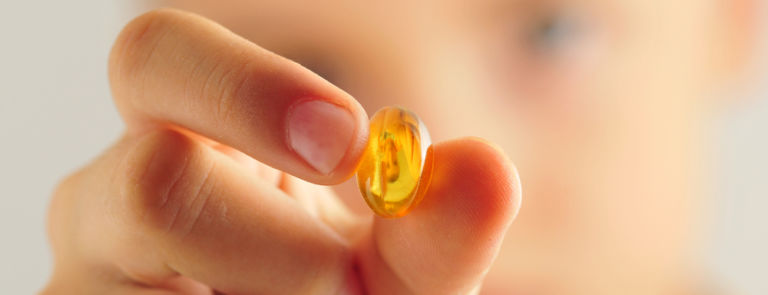10% off £35
7 benefits of omega-3 for kids

Expertly reviewed by Sarah Bushell, Registered Dietitian & Children’s Nutritionist
From foetus through to breastfeeding, toddler, teenage years and beyond, omega-3s are critical for growth, brain development, and may even influence behaviour.
So do our children get sufficient omega-3s from their diet? Or should we be supplementing their diets in order to increase their levels? We’ve got all the intel below.
In this article, you’ll find out:
- What omega-3s are
- The benefits of omega-3 for kids
- Children’s omega-3 dosage
- FAQs
- Omega-3 sources for kids
- All about kids’ omega-3 supplements
- Potential side effects of omega-3
What are omega-3s?
In short, omega-3s are fatty acids, which are vital components of yours and your child’s cell membranes.
They are used in every cell in our bodies are involved in the anti-inflammatory process and most of the fats within our brain is actually omega 3.
The three main omega-3 fatty acids are:
- Alpha-linolenic acid (ALA)
- Eicosapentaenoic acid (EPA)
- Docosahexaenoic acid (DHA)
Levels of DHA are particularly high in the eyes, brain, and sperm cells.1
The omega-3 benefits for kids
Omega-3s are called essential fatty acids, essential because you and your children cannot produce them on your own. And because we cannot produce them on our own, we need to get them in our diet.
These fatty acids are important for a variety of bodily functions, from IQ, cell growth to muscle activity.2
However, as with most nutrients, while getting enough omega-3s is important to avoid the various symptoms of a deficiency, it does not, therefore, follow that this will increase your child’s brain function and help them do better at school.
Omega 3s are most important in terms of the child’s growth and the development of their central nervous system.
-
May help concentration
Some research has shown that omega 3 may help children with and without ADHD. In children with ADHD omega 3 may help decrease impulsiveness, hyperactivity and increase their ability to concentrate.
-
Enhances brain functioning
Omega 3 is also linked to improved learning, planning, memory and brain development in infants and children, according to a study from 2009.4
-
Improves mood
Research suggests that omega 3 may even prevent depression and low mood in children.
-
Immune system
Omega-3s are needed for optimal immune function and children who don’t eat fish may benefit from supplementation.
-
Asthma
Omega-3s could also be linked to reduced symptoms of asthma in asthmatic children.13,14 But also they may offer a protective effect against developing asthma too.
-
Sleep
Some research has shown that children who have low levels of omega 3 in their blood also were more likely to have problems with sleeping.
When they were given omega 3 supplements, their sleep disturbances reduced.
Therefore, an adequate intake of these fatty acids should be ensured from pregnancy, through to breastfeeding, and then the child’s early years.15
FAQs
The WHO recommends the following:
| 6 months - 2 years | DHA 10-12mg/kg |
| 2 - 4 years | EPA + DHA 100-150mg / day |
| 4 - 6 years | EPA + DHA 150-200mg / day |
| 6 - 10 years | EPA + DHA 200-250mg / day |
So, do kids need omega-3? And is it good for them? As we’ve explained above, omega-3 can be very beneficial for children’s health, so we’d definitely give it the thumbs up for little ones!
Even babies’ can take omega-3, before they are born they get omega 3 via the placenta and in the first few months through their mother’s breastmilk if mum eats enough omega 3 in her diet.
Children get omega 3 from a diet rich in oily fish or can have omega 3 supplements in gummy or liquid format.
Studies show that omega-3 supplementation may have long-term neurodevelopmental effects that can reduce antisocial and aggressive behaviour problems in children.18
As well as this, a review of ten different studies found that omega-3 can have a small but significant impact on ADD/ADHD symptoms.19
Omega-3 sources for kids
To meet your kids’ daily omega-3 needs, you can consider feeding them more:
- Salmon (fish patties, fish nuggets, and salmon sliders often go down well)
- Sardines
- Mackerel
- Canned tuna with water
- Trout
- Herring
- Oysters
- Beef16
Some children will love sardines on toast, or a salmon stir-fry, with soy sauce and noodles.
Other kids may appreciate a good fish pie, or else a salmon risotto or pasta bake.21
Fish and chips are always popular. However, you should know that white fish don’t provide the same levels of omega 3. Neither does tuna unfortunately.
And it’s also worth noting that the deep-frying process of fish and chips means that this dish will have a higher concentration of omega-6 fats, which compete with omega-3s meaning they stop the body from actually using them.
Omega 6 fats are not unhealthy, it’s a question of getting the right balance between the two. You get omega 6 fats in vegetable oils, nuts and seeds, meat, poultry and eggs.
Vegetarian omega-3 sources for kids
If your child does not wish to eat fish, then you can obtain omega 3 from plant based sources::
- Flaxseeds
- Walnuts
- Chia seeds
- Soybeans
However these replacements contain a type of omega 3 called ALA and the conversion into the useful form of DHA and EPA is actually quite poor.22 Therefore Children who don’t eat oily fish should take an omega 3 supplement to ensure they get the recommended amounts for good health.
Other sources of omega 3
Bizarrely you can get omega 3 enriched hens’ eggs. This is when hens are fed seeds rich in ALA and their bodies convert it into DHA and EPA. Not all eggs are good sources of omega 3, you’ll need to shop around.
Giving kids omega-3 supplements
For a variety of reasons, you might struggle to feed your children oily fish once per week, every week.
These could be dietary choices, cultural reasons, budget, or simply have children who just do not like fish.
If that is the case, you should also consider omega-3 supplements.
Supplements come in chewable capsules of various flavours. They usually contain fish oil or an algal oil which is suitable for vegans. Check your supplement contains the right amounts of DHA and EPA omega-3s.23
Side effects of omega-3
Generally, it is hard to take too many omega-3s, and they are considered safe, with few to no side effects.20
Taking extremely high amounts of fish oil as a supplement could leave an aftertaste or have an impact on the child’s breath by causing a bad smell. It could also cause indigestion, nausea, loose stools, or a rash.21
Can a 12-year-old take fish oil pills?
Yes! Although remember its omega 3 we want and a generic fish oil supplement may not be the right fit. Look for something that’s specifically designed for this age group and ensure that the EPA and DHA dosage is right.
Side effects of omega-3
Generally, Omega-3 is considered safe, with minimal effects.24
Some fish oil supplements can have toxic effects, for example cod liver oil contains vitamin A and you can have too much of a good thing.
Taking extremely high amounts of omega 3 most often results in diarrhoea or loose stools, it’s our body’s way of getting rid of what we don’t need. Your child can also have bad breath indigestion, nausea, or a rash.25
The final say
Omega-3 fatty acids are key for keeping kids healthy, especially with their brain health.
There is better evidence for the health benefits of omega 3 that comes from oily fish than from any other form including supplements, but if your child doesn’t like fish or you don’t eat fish for whatever reason, a supplement is the next best alternative.
Choose one that is age appropriate and contains DHA and EPA in the correct dose whether that acquired from fish or the vegan algal oil form.
If you have any concerns about giving them omega-3 supplements, please speak to your GP and ask for a referral to a Registered Dietitian for personalised advice.
The advice in this article is for information only and should not replace medical care. Please check with your GP or healthcare professional before trying any supplements, treatments or remedies. Food supplements must not be used as a substitute for a varied and balanced diet and a healthy lifestyle.
- https://ods.od.nih.gov/factsheets/Omega3FattyAcids-Consumer/
- https://newsnetwork.mayoclinic.org/discussion/mayo-clinic-q-and-a-omega-3-supplements-for-children-what-does-the-research-show/
- https://www.theguardian.com/lifeandstyle/2006/oct/12/healthandwellbeing.health1
- https://pubmed.ncbi.nlm.nih.gov/19214053/
- https://www.ncbi.nlm.nih.gov/pmc/articles/PMC5603098/
- https://pubmed.ncbi.nlm.nih.gov/20130094/
- https://www.nestlenutrition-institute.org/news/article/2018/04/28/evidence-supports-omega-3-supplements-sharper-vision-children-meta-analysis
- https://pubmed.ncbi.nlm.nih.gov/19214053/
- https://www.ahajournals.org/doi/10.1161/circulationaha.114.015176
- https://pubmed.ncbi.nlm.nih.gov/22332096/
- https://www.futurity.org/prenatal-dha-child-obesity-blood-pressure-1991622-2/
- https://www.ncbi.nlm.nih.gov/pmc/articles/PMC5417803/
- https://www.ncbi.nlm.nih.gov/pubmed/11153584
- https://www.ncbi.nlm.nih.gov/pubmed/24605819
- https://www.ncbi.nlm.nih.gov/pmc/articles/PMC5417803/
- https://www.eatright.org/food/vitamins-and-supplements/types-of-vitamins-and-nutrients/do-kids-need-omega-3-fats
- https://www.eatright.org/food/vitamins-and-supplements/types-of-vitamins-and-nutrients/do-kids-need-omega-3-fats
- https://www.sciencedaily.com/releases/2015/05/150515134827.htm
- https://pubmed.ncbi.nlm.nih.gov/21961774/
- https://www.eatright.org/food/vitamins-and-supplements/types-of-vitamins-and-nutrients/do-kids-need-omega-3-fats
- https://www.theguardian.com/lifeandstyle/2006/oct/12/healthandwellbeing.health1
- https://www.eatright.org/food/vitamins-and-supplements/types-of-vitamins-and-nutrients/do-kids-need-omega-3-fats
- https://www.choice.com.au/babies-and-kids/feeding-children/making-healthy-choices/articles/omega-3-for-children
- https://www.choice.com.au/babies-and-kids/feeding-children/making-healthy-choices/articles/omega-3-for-children
- https://newsnetwork.mayoclinic.org/discussion/mayo-clinic-q-and-a-omega-3-supplements-for-children-what-does-the-research-show/














